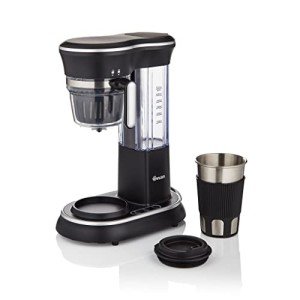Ten Things You've Learned In Kindergarden Which Will Help You With Whole Bean Coffee Machine
The Ultimate Guide to Whole Bean Coffee Machines
In an age where coffee enthusiasts have ended up being significantly critical, the choice of a coffee machine has ended up being more pivotal than ever. Whole bean coffee machines have actually emerged as a preferred amongst serious coffee drinkers, enabling them to draw out the freshest tastes from coffee beans. This post explores the complexities of whole bean coffee machines, exploring their features, benefits, and considerations for the passionate coffee lover.
What is a Whole Bean Coffee Machine?
A whole bean coffee machine is developed to grind coffee beans prior to developing, guaranteeing optimum freshness and flavor extraction. Unlike Coffee Bean Coffee Machine that count on pre-ground coffee, these machines include a grinder, which allows the user to choose the grind size suited to their brewing approach, from espresso to French press.
Benefits of Whole Bean Coffee Machines
Freshness: The main benefit of using whole beans is that they retain their taste longer than pre-ground coffee. Grinding prior to developing maintains Coffee Bean Machine that add to the total taste profile.
Customization: Many whole bean machines allow users to adjust grind settings, water temperature level, and developing time to develop a personalized cup of coffee that meets specific preferences.
Quality Control: Whole bean coffee machines empower users to pick top quality beans from various sources, making it simpler to check out distinct taste profiles.
Adaptability: These machines cater to various developing methods, enabling users to craft espresso, drip coffee, or specialized brews with ease.
Convenience: Integrated grinders streamline the coffee-making process, reducing the need for additional devices and minimizing cleanup.
Key Features to Consider
When selecting a whole bean coffee machine, numerous functions ought to be considered:
Grinder Type:
- Burr vs. Blade: Burr grinders provide a more uniform grind, which is important for consistency in flavor, whereas blade grinders tend to produce irregular grinds.
Brew Method Compatibility: Ensure the machine can accommodate the brewing technique chosen (e.g., espresso, pour-over, French press).
Capability: Consider the hopper size for holding coffee beans; larger capabilities imply less regular refilling.
User Interface: Look for machines with user-friendly controls, enabling users of all skill levels to operate them easily.
Maintenance: Machines that are easy to tidy and preserve will conserve time and ensure the longevity of the gadget.
Material Quality: Stainless steel and high-grade plastic deal toughness, while machines with glass elements tend to be less resilient.
Popular Whole Bean Coffee Machines
Brand name
Model
Mill Type
Capacity (Cups)
Features
Cost Range (₤)
Breville
BES870XL Barista Express
Burr
8
Espresso machine, steam wand
600 – 700
De'Longhi
EC702
Pump
10
Dual boiler system, stainless steel
300 – 400
Cuisinart
DCC-3200P1
Blade
14
24-hour programmable, drip coffee
50 – 100
Rancilio
Silvia
Burr
2
Expert feel, steam power
700 – 800
Hamilton Beach
49980A
Mixed
2
Single-serve, versatile developing
30 – 50
How to Make one of the most Out of Your Whole Bean Coffee Machine
To attain the best outcomes with a whole bean coffee machine, think about the following tips:
Quality Beans: Always select premium, fresh beans that fit your taste.
Grind Size: Adjust the grind size based upon the brewing method. Finer grinds are appropriate for espresso, while coarser grinds work much better for French press.
Brewing Temperature: Water temperature should generally be in between 195 ° F and 205 ° F (90 ° C -96 ° C) for optimal extraction.
Water Quality: Use filtered water for the very best taste and to extend the machine's life expectancy.
Maintenance Schedule: Regularly tidy the mill and machine to prevent residue accumulation and guarantee consistent efficiency.
FAQs about Whole Bean Coffee Machines
1. Is a whole bean coffee machine worth the investment?
Yes, if you value the freshness and taste of your coffee, investing in a whole bean coffee machine is helpful. It enables a richer and more fragrant cup of coffee compared to pre-ground alternatives.
2. How do I tidy my whole bean coffee machine?
Most machines feature cleaning instructions. Normally, you'll need to eliminate the grinder, clean the hopper, and run a cleaning cycle with water. Use brushes specifically developed for this function.
3. Can I use pre-ground coffee in a whole bean machine?
The majority of whole bean coffee machines are particularly developed for whole beans; nevertheless, some may enable you to use pre-ground coffee. Speak with the manufacturer's guidelines.
4. What is the best grind size for espresso?
A fine grind is usually preferred for espresso. However, experimentation can help discover the perfect grind size that matches your taste choices.
5. How typically should Best Bean Cup Coffee Machine replace the coffee beans?
For ideal freshness, it is motivated to use coffee beans within 2 weeks of opening after they have actually been roasted. Shop them in an airtight container away from light and wetness.
A whole bean coffee machine can raise the coffee experience, supplying freshness, modification, and exceptional taste. With numerous alternatives offered, prospective buyers can find a machine that fits their lifestyle and coffee preferences. By considering the aforementioned features, pointers for optimization, and maintaining a consistent cleansing regimen, users can savor every cup of newly brewed, aromatic coffee for many years to come. Whether for personal use or amusing guests, purchasing a whole bean coffee machine is a step towards coffee excellence.
